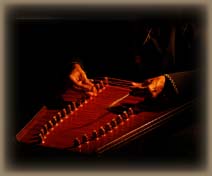
![]()

![]()
The Valley, Kashmir Valley, sang in many voices….through its streams,
falls, Chinar leaves rustling in the breeze and little boats gently strumming
the
ripple-strings of lakes with their oar -fingers. The heart echoed its
liquid notes
while the hands searched for means to reproduce them as and when and
where desired. At last, the voice of the Valley was captured between a
few
pieces of wood and strings.......“Santoor”
was born.
 There
are many different opinions about
There
are many different opinions about
the origin of this instrument. But there is a unanimous affirmative about
the soothing
grace and the haunting, lyrical and lively
qualities of the Santoor. The Santoor is a
very ancient instrument from the Kashmir
valley. It was mainly used as an
accompanying instrument in the type of
music called Sufiana Mausiqi.
The
original name of this instrument is Shata Tantri
Veena, or the instrument
with the hundred strings. Santoor is a Persian word. There are similar
instruments in different countries, e.g. Iran, China, Russia, Germany,
North America, where they exist with different names, shapes, and
styles of music according to the culture of that country, but following
the same basic principle of playing with wooden tongs on the strings,
stretched over the
box-like resonator.
The
original hundred stringed instrument had twenty-five bridges, carrying
four strings on each bridge covering two and a half octaves. The advanced
model of Santoor has twenty-nine or thirty-one bridges with three strings
on
each bridge. Thus increasing the range of the instrument and reducing
the
number of strings, to avoid the extra resonance or overlapping of notes
especially in the lower Saptaka or Octave.
Usually
the Santoor is made of walnut wood. It is
a trapezoid shaped
resonator box, which is approximately four inches hollow. It has an
arrangement of nails on one side for holding the strings and pegs for
tuning each string. When a string is stretched over the instrument, it
travels over a thin steel rod, fixed over the sidewall, then over the
bridge
(an ivory or horn piece is fixed over the bridge) and then to the other
sidewall of the instrument.
Thus
the actual striking portion of the string has ivory on one end and a
hard steel rod on the other end. Gentle strokes
of the wooden tongs on the
strings produce very delicate but lively sounds. The cast steel
wires are
used for the middle and higher octave while wound strings are used for
the
lower octave (normally the third string of the Spanish guitar).
When
using heavy weight tongs the sound gets suppressed and the stroke
gets harder. But when the lightweight tongs are used, the volume of sound
increases with the soft stroke.
Santoor is the only instrument, which produces soothing,
lyrical sound and
creates feeling, as if you are very much close to the nature.


Melodic Fusion Programmes l My Views